058
Threshold of Fire The Museum of Contemporary Art and Design (MADC) proudly concludes its 2010 exhibition agenda with the solo show “Threshold of Fire”, a collection of the most significant work of the prolific career of the Costa Rican artist Rafael Ottón Solís, a precursor of installation art in the country whose indelible trace is and will be source of inspiration for upcoming generations. Back in 1978, Solís assembled his first installation in the interior of a church in Moravia, where he displayed the triptych “On the North with Nicaragua” complemented with daily-life-objects arranged over a frame covered by sand. About 32 years later, precisely with a photograph of this art piece, “Threshold of Fire” finally opens. The display includes ten installations, one triptych, one assemblage, three paintings and one serigraphy, where installation art underlies as the driving force and bidimensional elements interact as supporting actors that contextualize the artist’s work. The museum spaces vibrate with symbolic elements that accompany visitors on their journey through the religious, regional, and international reality of political, social and boundary-related conflicts addressed from a deeply spiritual approach. It is actually this touch of mysticism
List of works Pag.16-17: On the North with Nicaragua. Acrylic on canvas and other materials.
Carlos Grant Collection.1978 Death in Bosnia.Installation. 2010. Pag.20-21: Mary at the foot of the cross. Installation. MADC Collection. 1990. Pag.22-23: We the Men. Installation. 1998. Pag.24-25: Bread and Blood. Installation. 1998. Pag.26-27: The Seven Little Sheep. Acrylic on canvas and other materials. (1979-1985). Santiago Atlitán. Acrylic on canvas and other materials. (1989-1991). Intolerance. Acrylic on canvas. (1991- 2010). Pag.28-29: Vigil on the verge of death. Installation. 1990. Pag.30-31: Oratory for Steve Biko. Acrylic on canvas and other materials.1989. Pag.34-35: Saint Romero of America. Space-Installation. (2003-2010). Pag.36-39: Six Jesuits at Dawn. Installation. 2010. Pag.44-45: Mud Temple. Installation. 2010. Pag.46-47: Easter. Installation. 1997. Pag.52-54: Blood for Oil. Installation.2003. Pag. 55: Blood for Oil. Serigraphy. 2003. Pag.18-19:
what gives a dimension of hope and faith to each one of his creations. Although most of Solís artworks deal with events that were news of major importance at the time (the Bosnia-Herzegovina conflict, the Civil War in El Salvador, etc.) they now become significantly relevant because of their universal characteristics, force, and perspective from where they were created. The museographic and exhibition design chromatically demystifies a black / red Solís to allow basic materials such as wood, coal, bricks, stones, fabrics and ribbons, grains, and metal play a leading role. The artist recreated his installations to integrate them into the Museum halls by articulating minimum resources and consequently constructing more abstract and synthetic works. With great accents on the combination of textures and contrasts -from the roughness of charcoal to the tenderness of velvet- Ottón offers powerful and poetic creations of paramount character that dramatize the human conflicts on altars and encourage reflection.
Fiorella Resenterra, Director, MADC, November, 2010
